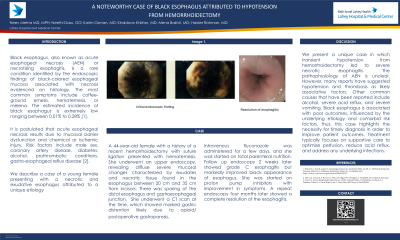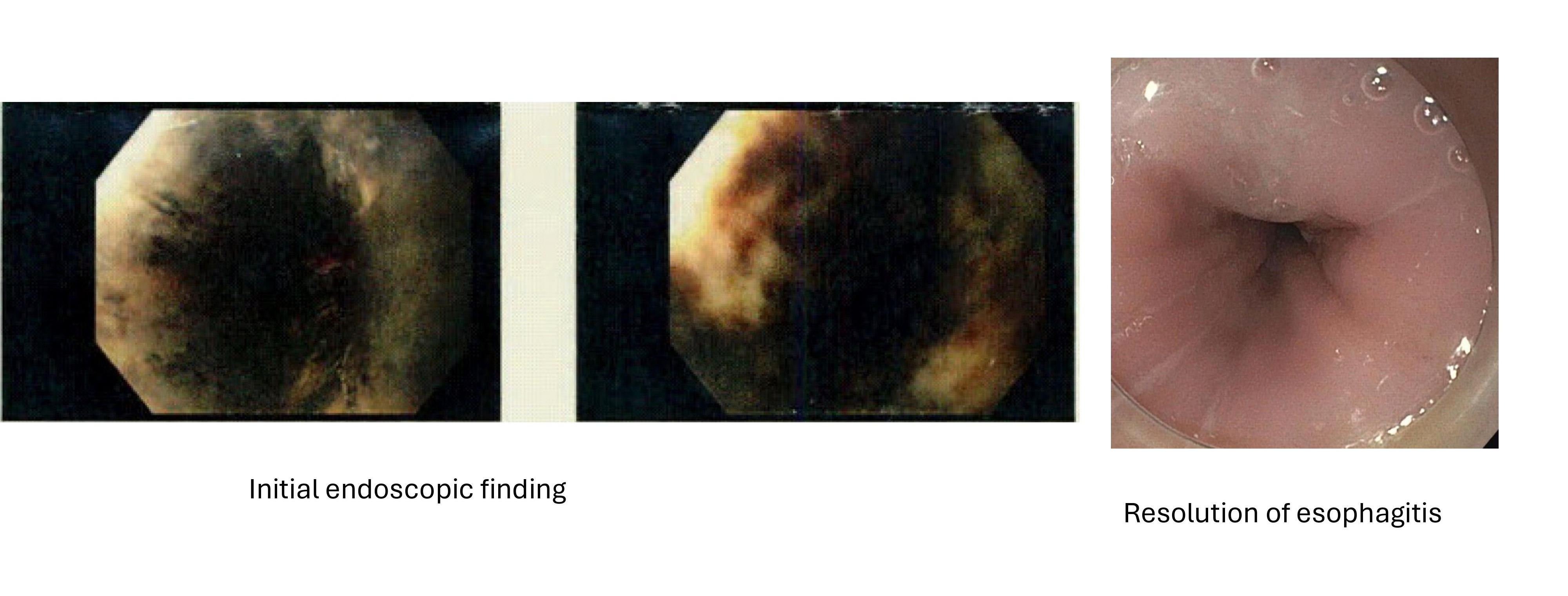Sunday Poster Session
Category: Esophagus
P0541 - A Noteworthy Case of Black Esophagus Attributed to Hypotension From Hemorrhoidectomy
Sunday, October 27, 2024
3:30 PM - 7:00 PM ET
Location: Exhibit Hall E

Has Audio

Neev Mehta, MD
Lahey Hospital and Medical Center
Burlington, MA
Presenting Author(s)
Neev Mehta, MD1, Neethi Dasu, DO2, Karim Osman, MD1, Khaldoon Khirfan, MD2, Mena Bakhit, MD1, Haider Rahman, MD1
1Lahey Hospital and Medical Center, Burlington, MA; 2Beth Israel Lahey Health, Burlington, MA
Introduction: Black esophagus, also known as acute esophageal necrosis (AEN) or necrotizing esophagitis, is a rare condition identified by the endoscopic findings of black-colored esophageal mucosa associated with necrosis evidenced on histology. The most common symptoms include coffee-ground emesis, hematemesis, or melena. The estimated incidence of black esophagus is extremely low ranging between 0.01% to 0.28%. We describe a case of a young female presenting with a necrotic and exudative esophagus attributed to a unique etiology.
Case Description/Methods: A 44-year-old female with a history of a recent hemorrhoidectomy with suture ligation presented with hematemesis. She underwent an upper endoscopy, revealing diffuse severe mucosal changes characterized by exudates and necrotic tissue found in the esophagus between 20 cm and 35 cm from incisors. There was sparing of the distal esophagus and gastroesophageal junction. She underwent a CT scan at the time, which showed marked gastric distention likely due to opioid/postoperative gastroparesis. Intravenous fluconazole was administered for a few days, and she was started on total parenteral nutrition. Follow up endoscopy 2 weeks later showed grade C esophagitis but markedly improved black appearance of esophagus. She was started on proton pump inhibitors with improvement in symptoms. A repeat endoscopy four months later showed a complete resolution of the esophagitis.
Discussion: We present a unique case in which transient hypotension from hemorrhoidectomy led to severe necrotic esophagitis. The pathophysiology of AEN is unclear. However, many reports have suggested hypotension and thrombosis as likely associative factors. Other common causes that have been reported include alcohol, severe acid reflux, and severe vomiting. Black esophagus is associated with poor outcomes, influenced by the underlying etiology and comorbid risk factors, thus, this case highlights the necessity for timely diagnosis in order to improve patient outcomes. Treatment typically focuses on supportive care to optimize perfusion, reduce acid reflux, and address any underlying infections.

Disclosures:
Neev Mehta, MD1, Neethi Dasu, DO2, Karim Osman, MD1, Khaldoon Khirfan, MD2, Mena Bakhit, MD1, Haider Rahman, MD1. P0541 - A Noteworthy Case of Black Esophagus Attributed to Hypotension From Hemorrhoidectomy, ACG 2024 Annual Scientific Meeting Abstracts. Philadelphia, PA: American College of Gastroenterology.
1Lahey Hospital and Medical Center, Burlington, MA; 2Beth Israel Lahey Health, Burlington, MA
Introduction: Black esophagus, also known as acute esophageal necrosis (AEN) or necrotizing esophagitis, is a rare condition identified by the endoscopic findings of black-colored esophageal mucosa associated with necrosis evidenced on histology. The most common symptoms include coffee-ground emesis, hematemesis, or melena. The estimated incidence of black esophagus is extremely low ranging between 0.01% to 0.28%. We describe a case of a young female presenting with a necrotic and exudative esophagus attributed to a unique etiology.
Case Description/Methods: A 44-year-old female with a history of a recent hemorrhoidectomy with suture ligation presented with hematemesis. She underwent an upper endoscopy, revealing diffuse severe mucosal changes characterized by exudates and necrotic tissue found in the esophagus between 20 cm and 35 cm from incisors. There was sparing of the distal esophagus and gastroesophageal junction. She underwent a CT scan at the time, which showed marked gastric distention likely due to opioid/postoperative gastroparesis. Intravenous fluconazole was administered for a few days, and she was started on total parenteral nutrition. Follow up endoscopy 2 weeks later showed grade C esophagitis but markedly improved black appearance of esophagus. She was started on proton pump inhibitors with improvement in symptoms. A repeat endoscopy four months later showed a complete resolution of the esophagitis.
Discussion: We present a unique case in which transient hypotension from hemorrhoidectomy led to severe necrotic esophagitis. The pathophysiology of AEN is unclear. However, many reports have suggested hypotension and thrombosis as likely associative factors. Other common causes that have been reported include alcohol, severe acid reflux, and severe vomiting. Black esophagus is associated with poor outcomes, influenced by the underlying etiology and comorbid risk factors, thus, this case highlights the necessity for timely diagnosis in order to improve patient outcomes. Treatment typically focuses on supportive care to optimize perfusion, reduce acid reflux, and address any underlying infections.

Figure: resolution of black esophagus
Disclosures:
Neev Mehta indicated no relevant financial relationships.
Neethi Dasu indicated no relevant financial relationships.
Karim Osman indicated no relevant financial relationships.
Khaldoon Khirfan indicated no relevant financial relationships.
Mena Bakhit indicated no relevant financial relationships.
Haider Rahman indicated no relevant financial relationships.
Neev Mehta, MD1, Neethi Dasu, DO2, Karim Osman, MD1, Khaldoon Khirfan, MD2, Mena Bakhit, MD1, Haider Rahman, MD1. P0541 - A Noteworthy Case of Black Esophagus Attributed to Hypotension From Hemorrhoidectomy, ACG 2024 Annual Scientific Meeting Abstracts. Philadelphia, PA: American College of Gastroenterology.
